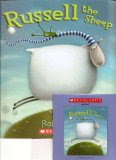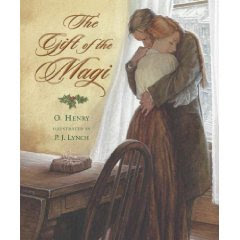
This story ends in someone's mouth, but it begins in a tiny village more or less covered in snow.
In a satiric send-up of The
Gingerbread Boy motif, Lemony Snicket, of
A Series of Unfortunate Events fame, gives us a latke who takes it on the lam, literally jumping out of the frying pan, through an open window, and into the snow-covered landscape outside.
Out there it's a winter wonderland, all right, with all but one of the rustic cottages decorated with flashing colored lights and other appurtenances of the Santa season, and our little latke, translated for the unknowing reader as "a word which here means "potato pancake," greets the scene with a loud, long (two-page) scream: "
AAAHHHHHHH!""What's all the ruckus?" inquires one of the ubiquitous flashing colored lights.
"We're the ones who are supposed to be dominating the neighborhood with our cheerful glow." The latke tries to explain that he's reacting to the pan full of hot oil which symbolizes the miracle of the temple's oil lamps after the Maccabees defeated Antiochus IV.
"Plus, frying makes my skin crispy and brown," explains the latke.
"So you're basically hash browns," said the flashing colored lights. "Maybe you can be served alongside a Christmas ham."
"I'm NOT hash browns." the latke protests. "I'm something COMPLETELY DIFFERENT!"
"AAAHHHHHHHH!"
Protesting being tossed into the secular Christmas stew as
hash browns, the little latke escapes his flashy fellow symbol only to find himself face to face with a peppy candy cane.
"I'm trying to sprinkle the night air with my peppermint scent," said the candy cane.
"All that yelping is spoiling the effect!" Patiently the latke explains that the mouth-watering smell of hot latkes reminds the people that they no longer have to study the Torah in secret caves, pretending to be gambling over a hot game of dreidel whenever soldiers approach.
"Sort of like Mary and Joseph hiding out in the manger," remarks the candy cane helpfully. "Someone should write Christmas carols about that!"
"I'm NOT part of Christmas," the latke objects. "It's a TOTALLY DIFFERENT thing!"
"AAAHHHHHHHH!"
Still steaming over becoming the subject of a Christmas carol, the latke plops down under a snowy pine tree in the forest.
"Are you a present?" the pine tree asked.
"Presents are pretty much the only things allowed to sit beneath me during this time of year.""Presents aren't really a big part of Hanukkah," the latke points out determinedly.
"It's more important to light the candles eight consecutive nights to commemorate the miracle in the temple..., so you shouldn't give up hope.""Plus, Santa Claus," said the pine tree.
"Santa Claus has nothing to do with it! Christmas and Hanukkah are COMPLETELY DIFFERENT things!"
"But different things can often blend together," said the pine tree. "Let me tell you a funny story about pagan rituals."
Just as the folklore-loving conifer launches into his literary lecture, a family comes cheerily trooping through the forest, the father armed with a well-sharpened axe.
"We'll never find a good one," grumps the father. "
You shouldn't give up hope," said the mother. "
Look! It's perfect!" said the daughter. "
It's beautiful," said the son. "
Such a marvelous shape!" said the mother. "
And its skin looks so crispy," said the father.
It seems that this family knows all about latkes, their symbolism and their succulent crispy skins as well. "
I'll refry it in oil to remind us of the rededication of the temple," said the practical mother.
"What was I thinking, bringing this axe?" said the father.
In his ironic spoof of the St. Nick-centric view of the holiday season, Lemony Snicket sets us all straight about the silliness of seeing Hanukkah as a hash-browned version of Christmas.
The Latke Who Couldn't Stop Screaming: A Christmas Story
has a bit of his droll tongue-in-cheek fun at the expense of the non-serious symbols of the season.
But somewhere in the world there is a place for all of us. Whether you are an electric form of decoration, a peppermint-scented sweet, a source of timber, or a potato pancake, on a cold, snowy night, everyone and everything should be welcomed somewhere, and the latke was welcomed into a home filled with people who understood what a latke is and how it fits into its particular holiday.
 And then they ate it.
And then they ate it.
A-A-A-H-H-H-H-H-H-H!
For another of Snicket's stories of the wintry season, see also his satiric stocking-stuffer,
The Lump of Coal.
Labels: Christmas Stories, Hanukkah Stories (Grades 2-5)






























